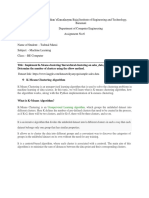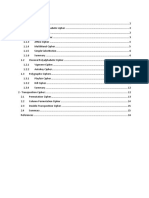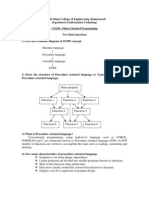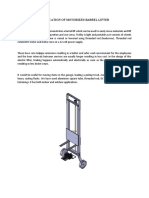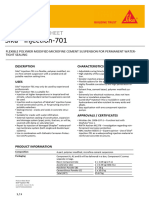Heart Disease PredictionUsing
Heart Disease PredictionUsing
Uploaded by
NationalinstituteDsnrCopyright:
Available Formats
Heart Disease PredictionUsing
Heart Disease PredictionUsing
Uploaded by
NationalinstituteDsnrOriginal Description:
Copyright
Available Formats
Share this document
Did you find this document useful?
Is this content inappropriate?
Copyright:
Available Formats
Heart Disease PredictionUsing
Heart Disease PredictionUsing
Uploaded by
NationalinstituteDsnrCopyright:
Available Formats
HEART DISEASE PREDICTION USING MACHINE LEARNING ALGORITHM
Abstract: Data mining, a great developing technique that revolves around exploring and
digging out significant information from massive collection of data implementation of data
mining in Medical domain field can yield in discovering information which can prove
beneficial in performing clinical diagnosis. As per today’s advanced and hi-tech living style,
the majority of the people are contracting heart disease which gives a sudden jolt to an
individual that at times one lacks time to get treated immediately. Hence, it's very much
essential that timely and early diagnosis is performed, which is being quite challenging
concern for the medical association. Poor and incorrect analysis carried out by the hospital
can be down its reputation and working. This project focuses on to build cost-cutting and
effective approach by the means of data mining techniques so that decision support system
can be enhanced. Predicting heart disease with the help of numerous attributes/symptoms is
quite complicated. The present research utilizes Naives Bayesian - data mining classification
technique for effectively enabling heart disease diagnosis and thereby offering appropriate
treatment. Supervising different medical factors and post operational period stands very
crucial. AES encrypts the patients’ records/data and save it in database. The results generated
reveals that the diagnostic system built successfully predict the heart diseases.
Keywords: Heart Disease, Naives Bayesian, Data Mining, Classification
I. INTRODUCTION less approximate prediction compared to
Navies Bayesian Algorithm in the proposed
Data mining process involves model in the project. As well the feature list
mining/extracting of very significant, and target list fitted into the algorithm gives
hidden and valuable information from large less predicting prices compared to the
databases. Usually the Healthcare sector Navies Bayesian, Comparatively Linear
involves abundant of data related to regression performs poorly when there are
patients, various diagnosis of the diseases non-linear relationships. They are not
etc… Nowadays the hospitals are adopting naturally flexible enough to capture more
the culture of hospital IMS (information complex patterns, and adding the right
management systems) in order to handle interaction terms or polynomials can be
their or patients data systematically and tricky and time-consuming.
effectively. Large quantity of data is
produced by such systems that are II.LITERATURE REVIEW
represented using charts, numbers, text and
images. Though such sort of data is hardly Kipp W. Johnson, BS, Jessica Torres Soto,
employed for making any clinical decisions. MS, Benjamin S. Glicksberg (2018),
Existing System: In existing system, k- “Artificial Intelligence in Cardiology”,
means algorithm has been deployed. for Elsevier, Journal Of The American College
withdrawing and exploring unknown Of Cardiology, Vol. 71, No. 23, pp. 2668 -
patterns from the databases, which can 2679.In particular, the paper first
assist in attending complicated inquiries reviews predictive modeling concepts
concerning the heart disease prediction. K- relevant to cardiology such as feature
means classifier, not efficient for predicting selection and frequent pitfalls such as
disease in statistical probability and real improper dichotomization. Second, it
time expert system why because that discusses common algorithms used in
projection accuracy is low. Disadvantages:, supervised learning and reviews selected
Using K-means classifier algorithm gives applications in cardiology and related
disciplines. Third, it describes the advent of This paper aims at analyzing the various
deep learning and related methods data mining techniques introduced in recent
collectively called unsupervised learning, years for heart disease prediction. The
provides contextual examples both in observations reveal that Neural networks
general medicine and in cardiovascular with 15 attributes has outperformed over all
medicine, and then explains how these other data mining techniques. Another
methods could be applied to enable conclusion from the analysis is that decision
precision cardiology and improve patient tree has also shown good accuracy with the
outcomes.Chala Beyene, Pooja Kamat help of genetic algorithm and feature subset
(2018), “Survey on Prediction and Analysis selection.Sumitra Sangwan, and Tazeem
the Occurrence of Heart Disease Using Data Ahmad Khan, Mar. 2015,“Review Paper
Mining Techniques”, International Journal Automatic Console for Disease Prediction
of Pure and Applied Mathematics, Vol. 118, using Integrated Module of Apriori and k-
No. 8, pp. 165-174. prediction of the mean through ECG Signal”, © IJTRE, Vol.
occurrence of diseases is necessary. One of 2, Issue 7, pp. 1368-1372. This research
the benefit of survey papers is to improve paper is mainly focused on predicting lung
the existing methodology for better decision and heart disease. Experimental based on
making by using different algorithms and ECG will show that many of the rules help
feature selection methods. Proposed in the best prediction of lung and heart
methodology uses J48, Naïve Bayes and disease, which even help doctors in their
Support Vector Machine algorithms for diagnostic decisions. Key words: Data
predicting the occurrence of heart disease mining, lung disease, heart disease, Apriori
for early automatic diagnosis and short time and K-means algorithm.
retrieve result that helps to give the qualities
of services and reduce costs to save the life III. IMPLEMENTATION
of individuals.Kaan Uyar, Ahmet İlhan
(2017), “Diagnosis of heart disease using This Proposed System focuses on heart
genetic algorithm based trained recurrent disease diagnosis by considering previous
fuzzy neural networks”, Elsevier B.V, data and information. To achieve this via
ICTASC, pp. 588–593.This study proposes Navies Bayesian in order to predict heart
a genetic algorithm (GA) based trained disease. For predicting the heart disease in a
recurrent fuzzy neural networks (RFNN) to patient, the following attributes are being
diagnosis of heart diseases. The University fetched from the medical profiles, these
of California Irvine (UCI) Cleveland heart include: age, BP, cholesterol, sex, blood
disease dataset is used in this study. Out of sugar etc... The collected attributes will act
total 297 instances of patient data, 252 are as input for the Navies Bayesian
used for training and 45 of them are chosen classification for predicting heart disease.
to be the testing. The results showed that The proposed approach includes the
97.78% accuracy was obtained from testing following stages: dataset collection, user
set. In addition to the accuracy, root mean registration and login (Application based),
square error, the probability of the classification via Navies Bayesian, and
misclassification error, specificity, prediction. Thereafter, a result is produced.
sensitivity, precision and F-score are This project making use of data mining
calculated. The results were found to be methods which are adopted for heart disease
satisfying based on comparison.Sharan prediction. The output reveals that the
Monica L, and Sathees Kumar B,February established diagnostic system effectively
2016, “Analysis of Cardiovascular Heart assists in predicting heart diseases.
Disease Prediction Using Data Mining
Techniques, © IJMCS, Vol. 4, Issue 1, pp.
55-58.
Comparison of ML Algorithms by assisting in diagnosis and identification
of diseases effectively, protecting and
enhancing patient’s life span, helping the
medical care takers in treatment plans and
cutting down medical cost. First is the
process of user registration wherein the user
must fill up the registration form through a
mobile application. After successful
completion of user registration, using the
system IP (internet protocol) address the
user can login anytime by using his/her own
username and password. Every registered
user’s credentials are saved in the database.
After this the complete symptoms list is
We observe that, we can achieve the best given including the affected clinical features
accuracy of 86.88524590163935% Naive like age, sex, cholesterol, sugar, ECG, chest
Bayes pain, Rest blood pressure, etc.
Prediction using ML Classification
This classification algorithm basically
Project Architecture: employs conditional independence, this
implies that value of an attribute for an
available class is not dependent on other
attribute values since the algorithm relies
upon the Bayesian theorem.
Navies Bayesian Based Prediction
A Naive Bayesian (NB) classifier, also
termed as “independent feature model"
relies upon the Bayesian theorem and acts
as a simple probabilistic classifier having
powerful independence hypothesis.
Generally, the NB classifier presumes that
the existence/absence of a specific class
feature is independent of the existence of
the other class feature. NB classifiers
usually perform in supervised learning. The
Modules classifier is based on conditional
independence, this implies that value of a
User Registration and Login variable for an available class is
Classification independent of other existing variable value.
Navies Bayesian Based Prediction In case of high dimensionality input, the
classifier is highly appropriate. Using Naïve
Modules Description Bayesian, models having predictive
potentials can be designed.
User Registration and Login
Data mining techniques have proven to be
extremely advantageous in healthcare sector
Algorithm get below screen of prediction
The Naive Bayes algorithm is based on
Bayesian theorem as given by equation (1.1)
Steps in algorithm are as follows:
1) Each data sample is represented by an n
dimensional feature vector, X = (x1,
x2….. xn), depicting n measurements
made on the sample from n attributes, Now below screen with different data
respectively A1, A2, An.
2) Suppose that there are m classes, C1,
C2……Cm. Given an unknown data
sample, X (i.e., having no class label),
the classifier will predict that X belongs
to the class having the highest posterior
probability, conditioned if and only if:
3) P(Ci/X)>P(Cj/X) for all 1< = j< = m and
j!= i Thus we maximize P(Ci|X). The For above screen data will get below result
class Ci for which P(Ci|X) is maximized
is called the maximum posteriori
hypothesis By Bayes theorem.
4) As P(X) is constant for all classes, only
P(X|Ci)P(Ci) need be maximized. If the
class prior probabilities are not known,
then it is commonly assumed that the
classes are equally likely, i.e. P(C1) =
P(C2) = …..= P(Cm), and we would
therefore maximize P(X|Ci). Otherwise, V.CONCLUSION:
we maximize P(X|Ci)P(Ci).
5) Note that the class prior probabilities Data collection is carried out using
may be estimated by P(Ci) = si/s , where numerous sources that are primary factors
Si is the number of training samples of responsible for any sort of heart disease and
class Ci, and s is the total number of thereby using a structure the database is
training samples. on X. That is, the constructed. This project focuses on
naive probability assigns an unknown establishing Heart Disease Prediction that
sample X to the class Ci [4] takes into consideration the approach of NB
(Naive Bayesian) classification algorithm
IV.OUTPUT SCREENS for resolving the issue of heart disease
prediction. Future work: Application
developers should work together with health
care professionals and researchers to deliver
disease apps which improve healthcare
outcomes. An overall of research process to
reduce delays would help to ensure
application based heart disease prevention
research is not entirely left behind by
In above screen after entering details will advances in technology.
9) Miss. Chaitrali S. Dangare, Dr. Mrs.
REFERENCES Sulabha S. Apte, “A Data mining
approach for prediction of heart disease
1) Purushottama. C, Kanak Saxenab, Richa using neural network’s”, IJCET,
Sharma (2016), “Efficient Heart Disease Volume 3, Issue 3, 2012, pp. 30-40.
Prediction System”, Elsevier, Procedia 10) S. U. Amin, K. Agarwal, and R. Beg,
Computer Science, No. 85, pp. 962 – “Genetic Neural Network Based Data
969. Mining in Prediction of Heart Disease
2) Kipp W. Johnson, BS, Jessica Torres Using Risk Factors” ,IEEE, ICT, 2013.
Soto, MS, Benjamin S. Glicksberg 11) Beant Kaur h, Williamjeet Singh,
(2018), “Artificial Intelligence in “Review on Heart Disease Prediction
Cardiology”, Elsevier, Journal Of The System using Data Mining Techniques”,
American College Of Cardiology, Vol. © IJRITCC, Vol.2, Issue: 10, p.p.3003-
71, No. 23, pp. 2668 - 2679. 08, 2014.
3) Chala Beyene, Pooja Kamat (2018), 12) Rishabh Saxena, Aakriti Johri, Vikas
“Survey on Prediction and Analysis the Deep and Purushottam Sharma “Heart
Occurrence of Heart Disease Using Data Diseases Prediction System Using CHC-
Mining Techniques”, International TSS Evolutionary, KNN, and Decision
Journal of Pure and Applied Tree Classification Algorithm”, ©
Mathematics, Vol. 118, No. 8, pp. 165- Springer, Advances in Intelligent
174. Systems and Computing, 2019, p.p.809-
4) Manpreet Singh, Levi Monteiro Martins, 819.
Patrick Joanis, and Vijay K. Mago 13) Ashok Kumar Dwivedi “Performance
(2016), “Building a Cardiovascular evaluation of different machine learning
Disease Predictive Model using techniques for prediction of heart
Structural Equation Model & Fuzzy disease”, © Springer, Computer
Cognitive Map”, IEEE, ICFS (FUZZ), Applications and Mathematics, 2016.
pp. 1377-1382. 14) Animesh Hazra, Subrata Kumar Mandal,
5) Shalet K.S, V. Sabarinathan, V. Amit Gupta, Arkomita Mukherjee and
Sugumaran, V. J. Sarath Kumar (2015), Asmita Mukherjee “Heart Disease
“Diagnosis of Heart Disease Using Diagnosis and Prediction Using
Decision Tree and SVM Classifier”, Machine Learning and Data Mining
International Journal of Applied Techniques: A Review”, Advances in
Engineering Research, Vol. 10, No.68, Computational Sciences and
pp. 598-602. Technology, Volume 10, Number 7
6) Kaan Uyar, Ahmet İlhan (2017), (2017) pp. 2137-2159.
“Diagnosis of heart disease using 15) Ashish Chhabbi,Lakhan Ahuja,Sahil
genetic algorithm based trained Ahir, and Y. K. Sharma,19 March
recurrent fuzzy neural networks”, 2016,“Heart Disease Prediction Using
Elsevier B.V, ICTASC, pp. 588–593. Data Mining Techniques”, © IJRAT,
7) Abhishek Rairikar, Vedant Kulkarni, Special Issue National Conference
Vikas Sabale, Harshavardhan Kale, “NCPC-2016”, pp. 104-106.
Anuradha Lamgunde “Heart Disease 16) [Kamal Kant, and Dr. Kanwal Garg,
Prediction Using Data Mining 2014, “Review of Heart Disease
Techniques” © IEEE, ICCC, 2017, p.p. Prediction using Data Mining
1-8. Classifications”, © IJSRD, Vol. 2, Issue
8) Theresa Princy. R, J. Thomas “Human 04, pp. 109-111.
Heart Disease Prediction System using 17) Sharan Monica L, and Sathees Kumar
Data Mining Techniques”, © IEEE, B,February 2016, “Analysis of
ICCPCT, 2016. Cardiovascular Heart Disease Prediction
Using Data Mining Techniques, ©
IJMCS, Vol. 4, Issue 1, pp. 55-58.
18) Sumitra Sangwan, and Tazeem Ahmad
Khan, Mar. 2015,“Review Paper
Automatic Console for Disease
Prediction using Integrated Module of
Apriori and k-mean through ECG
Signal”, © IJTRE, Vol. 2, Issue 7, pp.
1368-1372.
19) Rishi Dubey, and Santosh Chandrakar,
Aug. 2015, “Review on Hybrid Data
Mining Techniques for The Diagnosis of
Heart Diseases in Medical Ground”,
Vol. 5, Issue 8, pp. 715-718.
20) Monika Gandhi, Shailendra Narayan
Singh “Predictions in Heart Disease
Using Techniques of Data Mining”, ©
IEEE, ICFTCAKM, 2015, p.p. 520-525.
You might also like
- Bar Exam 2015 Suggested Answers in Labor Law by The UP Law Complex100% (1)Bar Exam 2015 Suggested Answers in Labor Law by The UP Law Complex17 pages
- Data Structure and Algorithm Design Assignment100% (1)Data Structure and Algorithm Design Assignment7 pages
- Modeling of Arduino-Based Prepaid Energy Meter Using GSM Technology0% (1)Modeling of Arduino-Based Prepaid Energy Meter Using GSM Technology3 pages
- Health: Quarter 1 - Module 1: Components of Consumer Health86% (37)Health: Quarter 1 - Module 1: Components of Consumer Health24 pages
- Disease Prediction and Treatment Recommendation Using Machine LearningNo ratings yetDisease Prediction and Treatment Recommendation Using Machine Learning8 pages
- Introductory Concepts of Probabability & StatisticsNo ratings yetIntroductory Concepts of Probabability & Statistics6 pages
- Probabilistic Reasoning in Artificial IntelligenceNo ratings yetProbabilistic Reasoning in Artificial Intelligence7 pages
- Recent Advances in Artificial IntelligenceNo ratings yetRecent Advances in Artificial Intelligence6 pages
- A Practical Approach To Linear Regression in Machine Learning - by Ashwin Raj - Towards Data ScienceNo ratings yetA Practical Approach To Linear Regression in Machine Learning - by Ashwin Raj - Towards Data Science20 pages
- Introduction To Python and Computer Programming 1704298503No ratings yetIntroduction To Python and Computer Programming 170429850344 pages
- Practical 5: Introduction To Weka For Classfication100% (1)Practical 5: Introduction To Weka For Classfication4 pages
- Data Scientist Certification Study GuideNo ratings yetData Scientist Certification Study Guide7 pages
- Semi-Automated Exploratory Data Analysis (EDA) in Python - by Destin Gong - Mar, 2021 - Towards DataNo ratings yetSemi-Automated Exploratory Data Analysis (EDA) in Python - by Destin Gong - Mar, 2021 - Towards Data3 pages
- Data Mining and Business Intelligence Lab ManualNo ratings yetData Mining and Business Intelligence Lab Manual52 pages
- A Comprehensive Statistics Cheat Sheet For Data Science 1685659812No ratings yetA Comprehensive Statistics Cheat Sheet For Data Science 168565981239 pages
- Cs2258 Database Management Systems Lab Manual: Prepared byNo ratings yetCs2258 Database Management Systems Lab Manual: Prepared by65 pages
- Problem Solving and C Programming - Handout - v2 (1) .1No ratings yetProblem Solving and C Programming - Handout - v2 (1) .1139 pages
- Disease Prediction Using Machine Learning: December 2020No ratings yetDisease Prediction Using Machine Learning: December 20205 pages
- Data Analysis & Probability - Task & Drill Sheets Gr. 3-5From EverandData Analysis & Probability - Task & Drill Sheets Gr. 3-5No ratings yet
- Design and Implementing Heart Disease Prediction Using Naives Bayesian Dept. of CseNo ratings yetDesign and Implementing Heart Disease Prediction Using Naives Bayesian Dept. of Cse16 pages
- Intelligent Heart Disease Prediction System Using Data Mining TechniquesNo ratings yetIntelligent Heart Disease Prediction System Using Data Mining Techniques7 pages
- Prediction of Cardiovascular Disease Using Machine Learning TechniquesNo ratings yetPrediction of Cardiovascular Disease Using Machine Learning Techniques6 pages
- A Data Mining Based Model For Detection of Fraudulent Behaviour in Water ConsumptionNo ratings yetA Data Mining Based Model For Detection of Fraudulent Behaviour in Water Consumption7 pages
- Assessing The Effectiveness of Riparian Restoration Projects Using Landsat and Preception Data From The Cloud Computing ApplicationNo ratings yetAssessing The Effectiveness of Riparian Restoration Projects Using Landsat and Preception Data From The Cloud Computing Application5 pages
- Social Distancing Monitoring Robot For QueueNo ratings yetSocial Distancing Monitoring Robot For Queue2 pages
- Future of Depository With Introduction of Payment Bank: A Game Changer To Capital MarketNo ratings yetFuture of Depository With Introduction of Payment Bank: A Game Changer To Capital Market1 page
- Opinion Minning On Feedback Management SystemNo ratings yetOpinion Minning On Feedback Management System10 pages
- Sensor Guided Robotics Using Ir Sensors and by Programming Micro Controller1550049190No ratings yetSensor Guided Robotics Using Ir Sensors and by Programming Micro Controller15500491901 page
- A Study On Depository System With Reference To Axis Bank LimitedNo ratings yetA Study On Depository System With Reference To Axis Bank Limited1 page
- Heart Beat Monitoring and Intimate by GSM at Abnormal Condition1522869000No ratings yetHeart Beat Monitoring and Intimate by GSM at Abnormal Condition15228690002 pages
- Intelligent Letter Box Using Arduino and GSM1554330059No ratings yetIntelligent Letter Box Using Arduino and GSM15543300592 pages
- Voice Controlled Robotic Vehicle1534238864No ratings yetVoice Controlled Robotic Vehicle15342388642 pages
- A Synopsis On: Consumer's Perception Towards Packaged Cold-Pressed Juices and Brand " PVT LTDNo ratings yetA Synopsis On: Consumer's Perception Towards Packaged Cold-Pressed Juices and Brand " PVT LTD3 pages
- Harmonic Mitigation Using 36-Pulse AC-DC Converter For Direct Torque Controlled Induction Motor DrivesNo ratings yetHarmonic Mitigation Using 36-Pulse AC-DC Converter For Direct Torque Controlled Induction Motor Drives10 pages
- Authentication by Encrypted Negative PasswordNo ratings yetAuthentication by Encrypted Negative Password3 pages
- Budgets and Budgetary Control of NFC (Nuclear Fuel Complex) 1583247683No ratings yetBudgets and Budgetary Control of NFC (Nuclear Fuel Complex) 158324768352 pages
- A Study On Budgetary Control at HDFC1567681191 PDFNo ratings yetA Study On Budgetary Control at HDFC1567681191 PDF28 pages
- Legal Aspect of Sex Workers in India: The Immoral Traffic (Suppression) Act SITA 1956No ratings yetLegal Aspect of Sex Workers in India: The Immoral Traffic (Suppression) Act SITA 19563 pages
- A Comparative Study To Find Out The Effects of Capsular Stretching Over Muscle Energy Technique in The Management of Frozen ShoulderNo ratings yetA Comparative Study To Find Out The Effects of Capsular Stretching Over Muscle Energy Technique in The Management of Frozen Shoulder50 pages
- General Laboratory Rules and Safety PrecautionsNo ratings yetGeneral Laboratory Rules and Safety Precautions11 pages
- Process Safety: Blind Spots and Red Ags: March 2011No ratings yetProcess Safety: Blind Spots and Red Ags: March 20117 pages
- A HPAE-PAD Chromatographic Assay For Carbohydrates in Urine As A Measure of Intestinal PermeabilityNo ratings yetA HPAE-PAD Chromatographic Assay For Carbohydrates in Urine As A Measure of Intestinal Permeability7 pages
- Tema Shell and Tube Heat Exchangers: 8-1-1 BP Oil Co. RPNo ratings yetTema Shell and Tube Heat Exchangers: 8-1-1 BP Oil Co. RP25 pages
- Risks and Mitigations For Losing EMS Functions Reference Document WebinarNo ratings yetRisks and Mitigations For Losing EMS Functions Reference Document Webinar11 pages
- t4 SC 131 Bioaccumulation Sequencing Cards - Ver - 2No ratings yett4 SC 131 Bioaccumulation Sequencing Cards - Ver - 22 pages
- Triplex Plunger Pump Preventive Maintenance GuidelinesNo ratings yetTriplex Plunger Pump Preventive Maintenance Guidelines1 page
- Lot 2 Generator and Outdoor Lighting DrawingsNo ratings yetLot 2 Generator and Outdoor Lighting Drawings7 pages
- Bar Exam 2015 Suggested Answers in Labor Law by The UP Law ComplexBar Exam 2015 Suggested Answers in Labor Law by The UP Law Complex
- Modeling of Arduino-Based Prepaid Energy Meter Using GSM TechnologyModeling of Arduino-Based Prepaid Energy Meter Using GSM Technology
- Health: Quarter 1 - Module 1: Components of Consumer HealthHealth: Quarter 1 - Module 1: Components of Consumer Health
- Disease Prediction and Treatment Recommendation Using Machine LearningDisease Prediction and Treatment Recommendation Using Machine Learning
- Introductory Concepts of Probabability & StatisticsIntroductory Concepts of Probabability & Statistics
- Probabilistic Reasoning in Artificial IntelligenceProbabilistic Reasoning in Artificial Intelligence
- A Practical Approach To Linear Regression in Machine Learning - by Ashwin Raj - Towards Data ScienceA Practical Approach To Linear Regression in Machine Learning - by Ashwin Raj - Towards Data Science
- Introduction To Python and Computer Programming 1704298503Introduction To Python and Computer Programming 1704298503
- Practical 5: Introduction To Weka For ClassficationPractical 5: Introduction To Weka For Classfication
- Semi-Automated Exploratory Data Analysis (EDA) in Python - by Destin Gong - Mar, 2021 - Towards DataSemi-Automated Exploratory Data Analysis (EDA) in Python - by Destin Gong - Mar, 2021 - Towards Data
- A Comprehensive Statistics Cheat Sheet For Data Science 1685659812A Comprehensive Statistics Cheat Sheet For Data Science 1685659812
- Cs2258 Database Management Systems Lab Manual: Prepared byCs2258 Database Management Systems Lab Manual: Prepared by
- Problem Solving and C Programming - Handout - v2 (1) .1Problem Solving and C Programming - Handout - v2 (1) .1
- Disease Prediction Using Machine Learning: December 2020Disease Prediction Using Machine Learning: December 2020
- Data Analysis & Probability - Task & Drill Sheets Gr. 3-5From EverandData Analysis & Probability - Task & Drill Sheets Gr. 3-5
- Design and Implementing Heart Disease Prediction Using Naives Bayesian Dept. of CseDesign and Implementing Heart Disease Prediction Using Naives Bayesian Dept. of Cse
- Intelligent Heart Disease Prediction System Using Data Mining TechniquesIntelligent Heart Disease Prediction System Using Data Mining Techniques
- Prediction of Cardiovascular Disease Using Machine Learning TechniquesPrediction of Cardiovascular Disease Using Machine Learning Techniques
- A Data Mining Based Model For Detection of Fraudulent Behaviour in Water ConsumptionA Data Mining Based Model For Detection of Fraudulent Behaviour in Water Consumption
- Assessing The Effectiveness of Riparian Restoration Projects Using Landsat and Preception Data From The Cloud Computing ApplicationAssessing The Effectiveness of Riparian Restoration Projects Using Landsat and Preception Data From The Cloud Computing Application
- Future of Depository With Introduction of Payment Bank: A Game Changer To Capital MarketFuture of Depository With Introduction of Payment Bank: A Game Changer To Capital Market
- Sensor Guided Robotics Using Ir Sensors and by Programming Micro Controller1550049190Sensor Guided Robotics Using Ir Sensors and by Programming Micro Controller1550049190
- A Study On Depository System With Reference To Axis Bank LimitedA Study On Depository System With Reference To Axis Bank Limited
- Heart Beat Monitoring and Intimate by GSM at Abnormal Condition1522869000Heart Beat Monitoring and Intimate by GSM at Abnormal Condition1522869000
- Intelligent Letter Box Using Arduino and GSM1554330059Intelligent Letter Box Using Arduino and GSM1554330059
- A Synopsis On: Consumer's Perception Towards Packaged Cold-Pressed Juices and Brand " PVT LTDA Synopsis On: Consumer's Perception Towards Packaged Cold-Pressed Juices and Brand " PVT LTD
- Harmonic Mitigation Using 36-Pulse AC-DC Converter For Direct Torque Controlled Induction Motor DrivesHarmonic Mitigation Using 36-Pulse AC-DC Converter For Direct Torque Controlled Induction Motor Drives
- Budgets and Budgetary Control of NFC (Nuclear Fuel Complex) 1583247683Budgets and Budgetary Control of NFC (Nuclear Fuel Complex) 1583247683
- A Study On Budgetary Control at HDFC1567681191 PDFA Study On Budgetary Control at HDFC1567681191 PDF
- Legal Aspect of Sex Workers in India: The Immoral Traffic (Suppression) Act SITA 1956Legal Aspect of Sex Workers in India: The Immoral Traffic (Suppression) Act SITA 1956
- A Comparative Study To Find Out The Effects of Capsular Stretching Over Muscle Energy Technique in The Management of Frozen ShoulderA Comparative Study To Find Out The Effects of Capsular Stretching Over Muscle Energy Technique in The Management of Frozen Shoulder
- Process Safety: Blind Spots and Red Ags: March 2011Process Safety: Blind Spots and Red Ags: March 2011
- A HPAE-PAD Chromatographic Assay For Carbohydrates in Urine As A Measure of Intestinal PermeabilityA HPAE-PAD Chromatographic Assay For Carbohydrates in Urine As A Measure of Intestinal Permeability
- Tema Shell and Tube Heat Exchangers: 8-1-1 BP Oil Co. RPTema Shell and Tube Heat Exchangers: 8-1-1 BP Oil Co. RP
- Risks and Mitigations For Losing EMS Functions Reference Document WebinarRisks and Mitigations For Losing EMS Functions Reference Document Webinar
- t4 SC 131 Bioaccumulation Sequencing Cards - Ver - 2t4 SC 131 Bioaccumulation Sequencing Cards - Ver - 2
- Triplex Plunger Pump Preventive Maintenance GuidelinesTriplex Plunger Pump Preventive Maintenance Guidelines
























